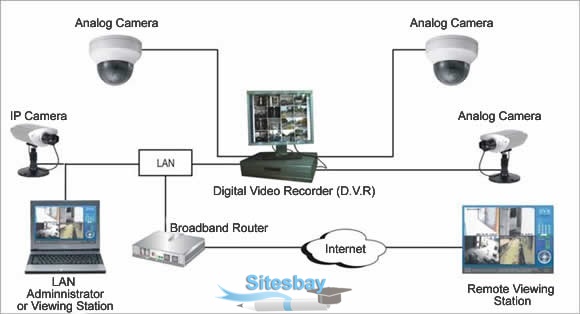CCTV Camera
Advertisements
What is CCTV Camera
CCTV stands for closed-circuit television and is commonly known as video surveillance. "Closed-circuit" means broadcasts are usually transmitted to a limited (closed) number of monitors, unlike “regular” TV, which is broadcast to the public at large. CCTV networks are commonly used to detect and deter criminal activities, and record traffic infractions,

CCTV technology was first developed in 1942 by German scientists to monitor the launch of V2 rockets. It was later used by American scientists during the testing of the atomic bomb.
Basic Components of CCTV
- Security Cameras (Analog or Digital)
- Cables (RJ45 or RJ59 Cables)
- Video Recorders (DVR or NVR)
- Storage Unit (usually a Hard Disk)
- Display Unit (optional, usually a monitor)
Places where CCTV's are generally installed
- Banks
- Shops and multiplexes
- Casinos
- City Roads and Highways
- Building and Residential Apartments
- Corporate Houses
- Government Offices and Buildings
- Airports and Railway Stations
- Industrial plants etc.
Benefits of CCTV
- CCTV systems are great deterrent to thieves. Once a thief realize that he is under surveillance of CCTV, he will prefer to go somewhere else.
- It reduces the fear of crime
- It facilitates remote monitoring
- It increases the business efficiency and improves profitability
- It can be used as a best option for home security
- It also increases the risks for shop lifters
- CCTV footage provides valuable assistance to the police in investigating crimes
Types of CCTV
There are three types of CCTV Camera availble in market they are;
- Analog Camera: Use Bayonet Neill-Concelman (BNC) connectors on coaxial cables to transmit continuous video signals.
- Digital Camera: Digitalize signals at camera level. These systems don’t require a video capture card as images are stored directly to a computer but require a (relatively) large amount of space to store recordings, so they are usually heavily compressed.
- Network or IP Camera: Used with analog or digital cameras, these systems utilize a video server to stream footage over the internet. The advantages are the possibility of WiFi and audio, Distributed Artificial Intelligence (DAI) for analyzing image footage, remote access, Power Over Ethernet (POE), and better resolution.
Google Advertisment

